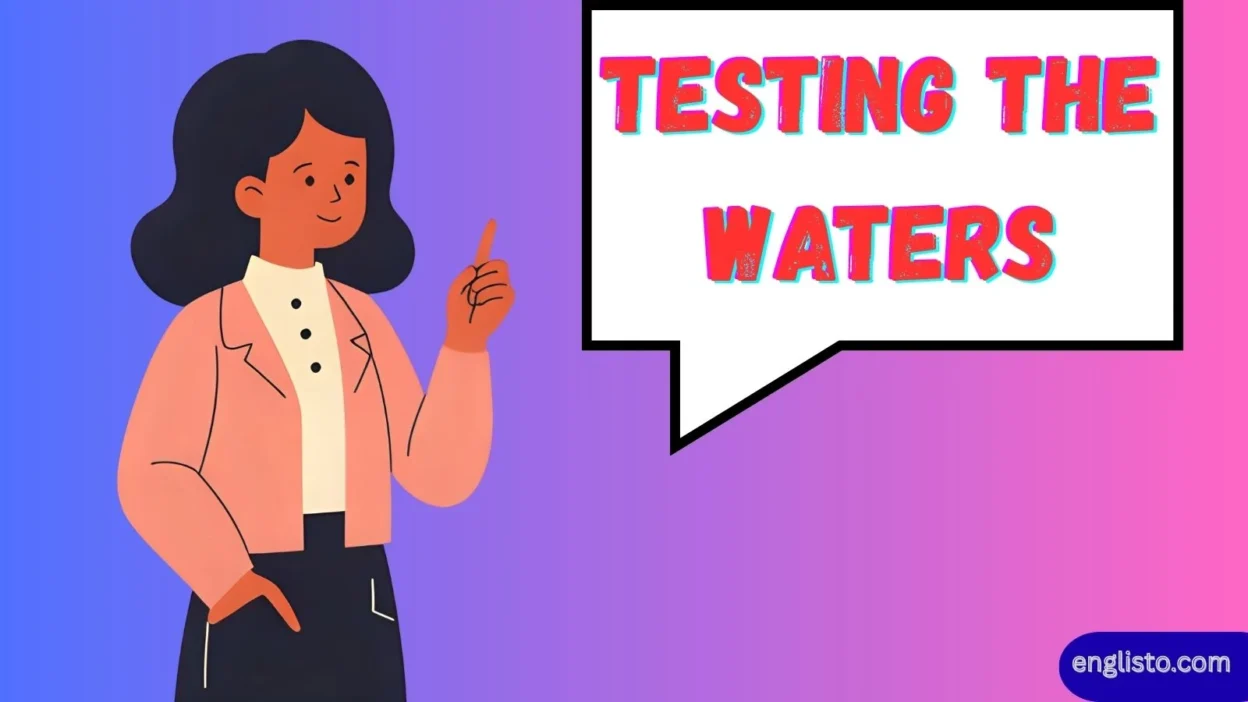Language is full of colourful expressions that draw from everyday experiences. One such phrase is “testing the waters”—an idiom that’s widely used in English conversations, writing, and even professional settings. It carries both a literal and metaphorical sense, helping people express caution, curiosity, or gradual exploration before diving fully into something new. Testing the Waters.
This article dives deep (pun intended!) into the idiom, its history, meaning, synonyms, cultural context, and practical examples. By the end, you’ll not only understand the phrase but also know how to use it confidently in different situations—whether in business, relationships, or everyday life.
What Does “Testing the Waters” Mean?
At its core, the idiom means to try something out in a small, careful way before committing fully. It’s about gauging or assessing a situation, idea, or reaction without taking on major risks.
Think of dipping your toe into a pool before jumping in. You’re not swimming yet—you’re just checking if the water feels comfortable. That’s the exact image behind this phrase.
Key ideas associated with the idiom include:
- Caution: Acting carefully before a big move.
- Exploration: Trying out a new idea or plan.
- Assessment: Gauging reactions, feedback, or suitability.
- Preparation: Taking an initial step before a larger commitment.
The Literal and Metaphorical Roots
The expression comes from the literal act of testing water temperature before bathing, swimming, or wading. In earlier centuries, before modern thermostats or heated pools, people would test water with a hand, toe, or foot to see if it was suitable.
Over time, this action became a metaphorical analogy for trying out new ventures carefully. Instead of water, the “unknown” could be:
- A new relationship
- A business idea
- A career change
- A political campaign
- Even a social interaction
This nautical and bathing imagery has since been woven into everyday English, making it one of the most popular, widely used idioms.
Read More: Seen vs Saw: Understanding the Difference in English Grammar
Synonyms and Alternative Expressions
Sometimes you may want to vary your language. Here are common synonyms and similar phrases:
| Expression | Meaning | Example Sentence |
| Dip your toes in | Try something lightly | She dipped her toes into yoga before committing to daily practice. |
| Put out a feeler | Test someone’s reaction | He put out a feeler about a possible promotion. |
| Take a crack at | Attempt or try | I’ll take a crack at painting before signing up for a class. |
| Sound out | Gauge opinions | The politician sounded out the public before announcing policy changes. |
| Trial run | Experimental attempt | We launched a trial run of the new app. |
| Pilot project | Small-scale test | The company ran a pilot project before full implementation. |
| Gauge the situation | Assess carefully | Let’s gauge the situation before acting. |
Everyday Usage and Examples
The idiom shows up in multiple contexts, from casual conversations to professional strategies.
In Personal Life
- “I’m just testing the waters with this new vegan meal plan to see how my body reacts.”
- “She’s testing the waters by reconnecting with old friends after years apart.”
In Business & Marketing
- “The company is testing the waters with a prototype before launching the full product.”
- “They’re testing the waters in international markets with a limited release.”
In Relationships
- “He tested the waters by casually mentioning marriage to see her reaction.”
- “They’re testing the waters of a long-distance relationship.”
In Politics
- “The candidate tested the waters with a fundraiser to gauge community support.”
- “Leaders often test the waters before introducing controversial policies.”
Why Do People “Test the Waters”?
The idiom reflects human instinct for caution and survival. Jumping straight into unknown situations can be risky, so people naturally prefer to assess conditions before fully committing.
Some common reasons include:
- Risk management: Avoiding hazards or losses.
- Gathering feedback: Checking reactions before making decisions.
- Strategic planning: Ensuring timing and readiness.
- Psychological comfort: Easing into change gradually.
Practical Applications in Different Areas
This idiom is more than just a figure of speech—it mirrors real-life strategies. Let’s see how it plays out across fields:
Business and Entrepreneurship
Entrepreneurs rarely gamble everything at once. They “test the waters” by:
- Launching a minimum viable product (MVP)
- Running market research surveys
- Conducting focus groups
- Offering samples to gauge customer response
Careers and Jobs
Professionals test the waters when:
- Trying a part-time project before full-time commitment
- Interning or freelancing to explore a new field
- Switching roles cautiously within a company
Relationships
In dating or friendships, testing the waters might mean:
- Starting with casual conversations before deeper commitment
- Sharing opinions carefully to gauge compatibility
- Reconnecting gradually with old ties
Politics and Leadership
Politicians often:
- Use opinion polls to test the waters
- Float policy proposals in media before implementation
- Launch pre-electoral campaigns to assess voter support
Idiom in Literature and Culture
Writers often use “testing the waters” in both literal and figurative ways. It captures the human condition of uncertainty and exploration. Books, speeches, and conversations use the phrase to highlight tentative beginnings and the desire for safety before risk.
Grammar Notes and Sentence Structure
The idiom functions as a verb phrase. It’s usually paired with be, start, try, or just.
Examples in different tenses:
- Present: “I’m testing the waters with this idea.”
- Past: “She tested the waters before launching the campaign.”
- Future: “We’ll test the waters before making a big move.”
It’s flexible enough to fit into both casual and formal English.
Cultural Significance and Universality
While rooted in English, the concept exists across cultures. Almost every society has expressions about caution before commitment:
- In Chinese, dipping a toe in water is often linked with gradual adaptation.
- In French, phrases like tâter le terrain (literally, “to feel the ground”) carry the same meaning.
- In Spanish, sondear el terreno also means to sound out or test reactions.
This universality shows how deeply human the idea of “testing first, diving later” really is.
Idioms Similar to “Testing the Waters”
Here’s a quick comparison table:
| Idiom | Nuance | Example |
| Wait and see | Delay action until conditions are clearer | “Let’s wait and see before making decisions.” |
| Play it safe | Avoid risk | “They played it safe with a soft launch.” |
| See how it goes | Begin without full plan, adjust later | “I’ll try the job and see how it goes.” |
| Feel one’s way | Proceed slowly and carefully | “He felt his way into the new career.” |
Practical Tips for Using the Idiom
- Use it when describing early, tentative steps.
- Pair it with verbs like start, try, see, check.
- Apply it in contexts where risk and caution are involved.
- Don’t use it for situations that involve instant or forced decisions.
FAQs
Q1: Is “testing the waters” formal or informal?
It’s versatile—suitable for both casual conversation and professional writing.
Q2: What’s the opposite of “testing the waters”?
Jumping in headfirst, diving in, or making a full commitment without hesitation.
Q3: Can I use it in academic writing?
Yes, if the context involves gradual testing, pilot studies, or exploratory research.
Q4: Is it always about risk?
Not always—it can also be about curiosity, exploration, or gaining comfort.
Q5: What’s the difference between “testing the waters” and “trial and error”?
“Testing the waters” suggests cautious, initial steps, while “trial and error” implies repeated experimentation until success.
Conclusion
“Testing the waters” is more than just a catchy idiom—it’s a reflection of human behavior. Whether we’re launching a product, exploring a relationship, or easing into new experiences, we often prefer to check conditions first before fully committing.
It’s a phrase that captures caution, strategy, and curiosity all at once. By using it effectively, you not only enrich your English but also express a timeless idea: sometimes, the smartest way forward is to dip a toe in before diving deep.



